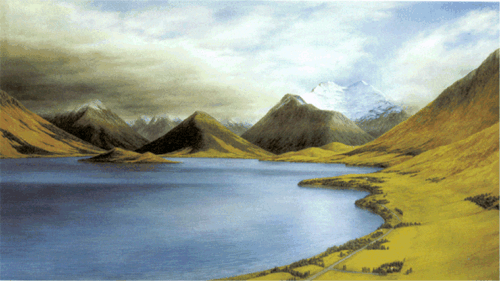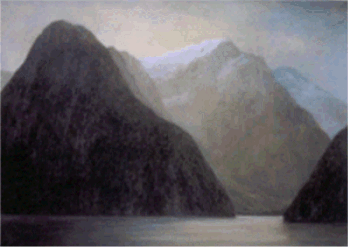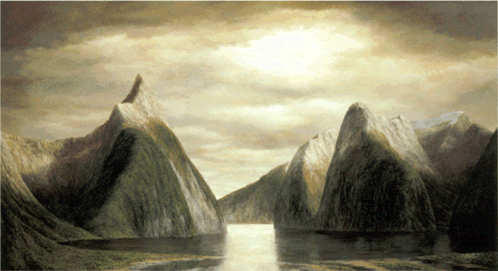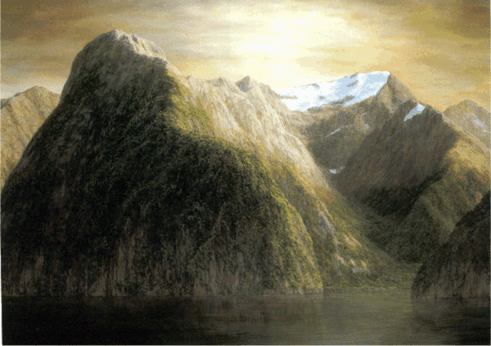Painting North / Pointing South:
Peter Siddell's Perspective on the Alps
RICHARD WOLFE
In his spare time before he became a painter, Peter Siddell climbed the Southern Alps. Some four decades later, in a departure from his trademark views of suburban Auckland, he returned to the mountains of his youth. This going over of old ground was prompted by a family trip to the South Island which took in, pointedly, Milford Sound, Lake Wakatipu and the West Coast. Back home Siddell looked up photographs of earlier excursions and began the series of ‘then and now’ paintings which resulted in his Three Points South exhibition.(1) This was not the first time he had tackled mountains on canvas, but on this occasion it would lead him down a well-worn path, to Milford Sound.

PETER SIDDELL Main Divide from Gillespies Beach March 2000 2000 Oil on canvas, 250 x 900 mm.
Sealers and whalers were probably the first Europeans to venture into the fiord that became known as Milford Sound. Mitre Peak, near the head of this narrow canyon, was so named during a coastal survey in 1848-51. This trip also produced the first known painting of this remarkable landscape, a panorama which included the ship Acheron.(2) Twelve years later, a similar view was the subject of botanist and draughtsman John Buchanan.(3) Soon, Australian artists were visiting the region; Nicholas Chevalier in 1867-8 and Eugene von Guérard in 1876. The latter made the four-and-a-half day voyage over from Melbourne, and in Milford Sound was greeted by scenery described as ‘unsurpassed if equalled by any cynosure of beauty on the earth’s surface’.(4) Von Guérard also visited Lake Wakatipu, and back in Melbourne he painted the amply titled Milford Sound with Pembroke Peak and Bowen Falls on the West Coast of Middle Island, New Zealand and Lake Wakatipu with Mount Earnslaw, Middle Island, New Zealand. They were an immediate success, and first exhibited at the Victorian Academy of Art in 1877. Then followed the Exposition Universelle de Paris (1878), the Sydney International Exhibition (1879)—where the artist received a ‘first degree of special merit’—and the Melbourne International Exhibition (1880). At the Colonial and Indian Exhibition in London (1886) von Guérard’s Milford Sound was singled out as ‘a fantasia in oils, so strange is its aspect, so suggestive of the magic land of romance and witchcraft’.(5)
While von Guérard raised Milford Sound’s profile overseas, back home the view was popularised on postcards, postage stamps and place-mats. A century on, Peter Siddell decided to paint what had now become one of the most recognisable images of New Zealand. He was stimulated by von Guérard’s painting, brought over from the Art Gallery of New South Wales, Sydney in 1990 to join its companion in the Auckland Art Gallery’s Two Centuries of New Zealand Landscape. This exhibition also included Buchanan’s watercolour, and one of Siddell’s own rearrangements of suburban Auckland.(6)

PETER SIDDELL Lake 2000 Oil on canvas, 1000 x 1800 mm.
Having already clambered over large parts of this landscape, Siddell feels better equipped to paint it. Familiarity drew him to the challenge of Milford Sound; he would not have attempted it had he not visited it. He can’t paint what he doesn’t know, admitting that in certain overseas subjects his trees look uncannily like pohutakawa or rimu. He has a first-hand knowledge of alpine forms—much as he has with house construction—and aims to paint a mountain that looks as if it could be climbed. At Milford there was no avoiding the classic view, but he did buck convention somewhat by raising the viewpoint. Following von Guérard’s lead he then moved on to Lake Wakatipu. Mt Earnslaw, at the head of the lake, was the first alpine summit Siddell had climbed, and one he’s been drawn back to on several occasions.
Working on what he calls a ‘thematic spiral’, Siddell regularly returns to earlier themes. His Three Points South represent the point on the spiral where he first started painting. As with most beginners, he started with familiar subjects. Mountains naturally figured largely in his earliest paintings, and most of these remain unexhibited.
Siddell draws his images freehand on the canvas, utilising a large number of his own photographs. These cover a range of angles and conditions, and the final composition is therefore a construction rather than a copy. In Three Points South his mountains are intentionally steeper, appealing to the eye rather than the photograph. He suggests the camera is less truthful, and that Charles Heaphy’s version of Mt Taranaki was precipitous because that’s how he saw it. The computer now plays an important part in Siddell’s process, assisting in the ordering and analysing of visual information. Initial compositions are done on an electronic drawing tablet, superseding jotter pad sketches that once littered the studio floor. The computer is used to resolve initial decisions of colour, tone and placement, but Siddell doesn’t foresee it posing any threat to painting. In the end, the final composition has to be worked out on the scale of the canvas, and the paint applied by the artist.
Although dominated by two large paintings, the Three Points South series had more modest beginnings.
Along with Milford and Wakatipu, Siddell also visted Gillespies Beach, to the west of Fox Glacier. From here he was able to look up at the Southern Alps, the opposing view to the one he had over 40 years earlier as a climber, down through patches of cloud to a thin strip of distant surf. This visual dialogue produced two sets of paintings, of Gillespies paired with the Main Divide and Mt Tasman, the latter two based on photographs taken in 1958 and 1967 respectively.
Von Guérard’s two grand canvases set the scale, for Siddell’s are intentionally of almost identical size.
However, his view of Milford Sound is much closer in spirit to Buchanan’s. That image, reproduced on the cover of Gil Docking’s Two Hundred Years of New Zealand Painting, sat beside his easel, but Siddell was not preconditioned. On the contrary, this mountaineer was familiar with the landscape long before he’d discovered Buchanan’s watercolour.

PETER SIDDELL Mist 2000 Oil on canvas, 250 x 365 mm.
As a general rule, Siddell doesn’t obey the laws of linear perspective. To do so on a large scale, with all the requisite vanishing points, can lead to absurdities. He concedes to a degree of convergence, but prefers a more intuitive ordering of the landscape. With objects of known size, such as Auckland’s ubiquitous villas, he depends on tone rather than line. He merely creates the illusion of perspective, and if his paintings appear perfect he warns they won’t stand close inspection. Linear perspective is, of course, wasted on irregular landforms such as the Southern Alps. Thus liberated, Siddell creates his illusions based entirely on the recession of tone.
Siddell goes about painting as a way of ‘ordering [his] own personal experience’. In so doing he aims for static images, to seize the moment. His urban reworkings are curiously becalmed and famously devoid of references to the march of time or its consequences: no automobiles, residents, or even peeling paint on their houses. This chronological challenge dates from the observations of the artist as paper boy, trudging the early morning streets of a deserted city.(7) In a sense the effect is two-fold; the fixing of one moment within another much larger period of time. The latter may cover a century or so, as defined by Siddell’s plentiful stock of villas, although the recent appearance of mirror-glass does make dating more precise. Down south, his landscapes are primeval, apart from minor modifications in the interests of scale. Just as the first known—albeit anonymous—artist to succumb to Milford Sound included the ‘Acheron’ in the picture, Siddell has used a cluster of small buildings. He did so because they were there, and concedes he has been generous with their size. In which case this human intrusion is even more insignificant than represented here, overwhelmed by pinnacles of rock. Similarly, Siddell has added two minuscule farmhouses to the manicured paddocks in the foreground of his Lake Wakatipu.

PETER SIDDELL Fiord 2000 Oil on canvas 1000 x 1800 mm.
The titles of the two largest paintings—Fiord and Lake—give little away, but there is no mistaking such recognisable scenes. While both contain modest evidence of human presence, others in Three Points South have none at all. Here Siddell is working within a more expansive geological time frame, and has the challenge of capturing—even ‘freezing’—the moment. But beyond the reach of ornamental villas, these landscapes do not offer the same sort of temporal opportunities. They are not ‘still’ in the sense that Siddell’s other subjects are oblivious to the passage of time, for here the weather and mood could change at any moment. It seems that these landscapes were motivated more by the artist’s long-standing concern for the natural environment. While this may not be so apparent in his immaculately scrambled suburbia, down south the message is clear.

PETER SIDDELL Sea Level 2000 Oil on canvas, 880 x 1200 mm.
Unlike their predecessors, Siddell’s paintings of Milford Sound and Lake Wakatipu will hardly attract the description ‘cynosure of beauty’. Nor were they intended to celebrate a ‘magic land of romance and witchcraft’. If von Guérard achieved as much it was by resorting to such devices as cascading waterfalls, mirror-like reflections and a mysterious Maori canoe. The mystery of the latter is mainly its origin, for it is seriously out of place on Lake Wakatipu. The same artist performed additional ‘witchcraft’ with his remarkable attention to detail. Even if Siddell’s own technique—honed on weatherboards and turned finials—seems meticulous enough, he considers von Guérard’s impossible to match. He’s with John Buchanan, whose interpretation speaks more of elemental forces than sublime beauty. Siddell has brought a cooller, sharper focus to a landscape which has no need of fairy grottos or ethnic idylls. If he is less than awe-struck by such southern peaks it is because he’s climbed them, and got the measure of this land.
Landscapes have been a recurring but minor theme in Peter Siddell’s painting, and Three Points South is the first exhibition of such work. With their completion he will turn to another point on his thematic spiral. Unlike von Guérard’s canoe—an obvious construction which appears to be going backwards—Siddell knows where he is headed. Even while Milford Sound was on his easel, from the attic studio in his Mt. Eden villa he kept an eye on the local landscape. Now he may go back to an earlier series, and another aspect of his youth: Grey Lynn through the eyes of a Herald delivery boy.
Comments by Peter Siddell were made to the writer in November 2000.

PETER SIDDELL Gillespies Beach from Main Divide January 1958 2000 Oil on canvas, 250 x 900 mm.
1. Three Points South, Artis Gallery, Parnell Road, Auckland. 29 November-20 December 2000. 2. Unknown artist, H.M.S. Acheron in Milford Sound 1851, reproduced in Gil Docking, Two Hundred Years of New Zealand Painting, A.H. & A.W. Reed Ltd, Wellington 1971, p. 37. 3. John Buchanan, Milford Sound, looking north-west from Freshwater Basin, from the collection of the Hocken Library, Dunedin. 4. Otago Daily Times, 28 January 1896 (quoted in Candice Bruce, Eugen von Guérard, Australian Directors Council, 1980, p. 104). See also Roger Blackley, Two Centuries of New Zealand Landscape Art, Auckland City Art Gallery, 1990, p. 41. 5. Charles C. Eldredge, Pacific Parallels: Artists and the Landscape in New Zealand, The New Zealand-United States Arts Foundation, Washington, D.C., 1991, pp. 26, 59 (reference no. 55), reprinted from J.A. Blaikie, ‘Art in New Zealand’, The Magazine of Art, London, 1887, p. 35. 6. Peter Siddell, A Place to Stand (1978) from the collection of the Dunedin Public Art Gallery. 7. Urban Memory: Paintings by Peter Siddell, Robert McDougall Art Gallery, Christchurch, 1986. ‘Peter Siddell talks to Art New Zealand’, Art New Zealand 43, Winter 1987, p. 43.
